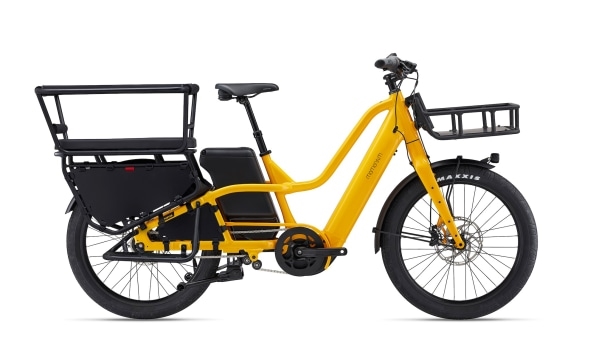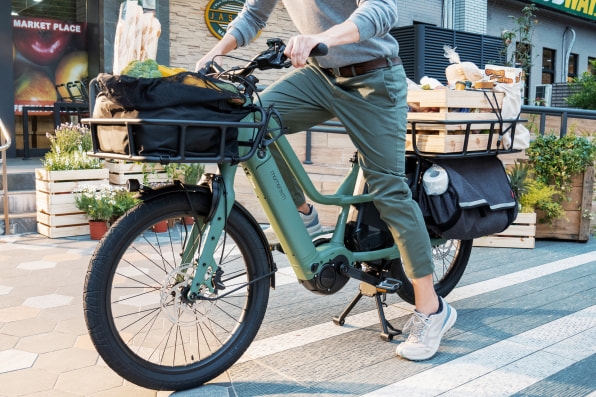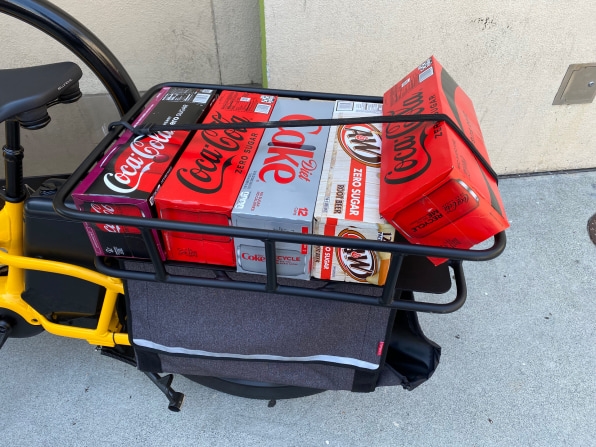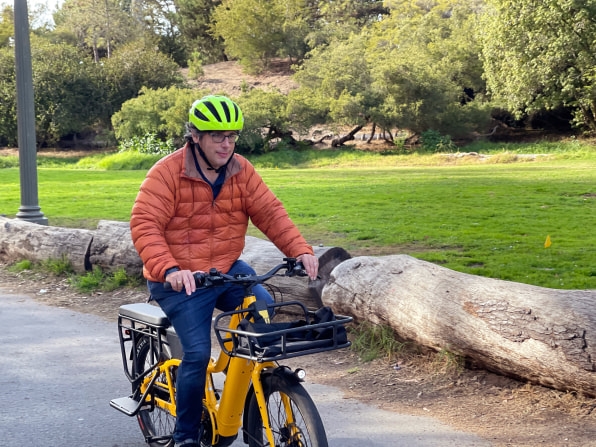Momentum PakYak E+ review: This e-bike thinks it’s a car
Over the past year and a half, I’ve spent an enormous amount of time pedaling around the San Francisco Bay Area on my Gazelle e-bike. The 3,800 miles I’ve covered have been great fun and good exercise. But I didn’t think of them as an alternative to driving. Cars–in case you hadn’t heard–excel at hauling multiple people and their possessions. My Gazelle, on the other hand, carries me and a pannier bag that can accommodate roughly one small grocery bag’s worth of stuff.
There is, however, a whole category of e-bikes optimized for ferrying heavy loads, whether they involve more than one person, items in bulk, or some combination thereof. Known as cargo e-bikes, they’ve got oversized racks and other affordances for transporting goods, options for passenger seating, and electric motors that are powerful enough to bear the burden. Recently I got to spend some extended time with one such e-bike, Momentum’s PakYak E+.

[Photo: courtesy of Momentum]
Though Momentum is not a big-name bicycle brand, it’s an arm of Giant—the appropriately-named enormous bike manufacturer based in Taiwan. The company aims its Momentum models at city dwellers, a market that makes particular sense for a cargo e-bike. Cities, after all, are usually terrible places to drive and park a four-wheeled vehicle. With many urban journeys consisting of just a few miles, it’s possible to swap a car for an e-bike for such trips. Unless you delight in being stuck in traffic, the e-bike might even be the superior form of transportation.
If you haven’t been keeping tabs on e-bikes, the PakYak E+’s list price–$5,500–might startle you. Though there are plenty of other models that cost that much, it’s way more money than you need to spend to get a cargo e-bike: Rad Power Bikes’ RadWagon 4, for example, starts at $1,800. But the PakYak is tricked out in all sorts of impressive ways that help to explain its price.
For starters, it’s a Class 3 e-bike, which means that its Yamaha SyncDrive Pro motor assists your pedaling at speeds up to 28 miles per hour, rather than the 20 mile limit of e-bikes such as the RadWagon. Instead of using typical derailleur gears for shifting, it’s got a Shimano Nexus hub, which lets you choose between five speeds even when the bike isn’t moving, and–because it’s sealed–offers low-maintenance reliability. Luxury touches include a motorcycle-style kickstand that keeps the bike upright and stable, a lockable storage bin, and a smartphone app that connects to the e-bike via Bluetooth for purposes such as trip logging and diagnostics. A lever on the left handle lets you quickly raise and lower the seat; that, along with the bike’s relatively short stature and low step-over height, facilitates family members of varying heights sharing the bike.

[Photo: courtesy of Momentum]
For all of the PakYak’s fancy features, I did find two basic design issues to be minor ongoing irritants. The handlebar-mounted controller you use for tasks such as adjusting the level of pedaling assistance has a color screen, but it’s on the small side and was much tougher to read at a glance than the larger monochrome display on my own e-bike. And the PakYak’s charging port is located down near the pedals, where it’s tough to reach; I never got the knack of inserting the oddly-shaped plug on the first try.
While the PakYak comes loaded with standard equipment, the raft of accessories Momentum offers are even more critical to its utility as a car substitute. For instance, if the rear rack and roomy front basket aren’t enough, you can add a gigantic rear basket with a 100 lb. capacity. Or you can occupy the same rear space with a passenger seat and footrests. There’s an optional safety bar that lets a child ride securely on the back, or you can use third-party seats to carry up to two kids. To extend the distance you can bike with motorized assistance, you can buy an auxiliary battery that sits inside the storage compartment. (E-bike ranges vary wildly depending on terrain, cargo weight, and even weather: Momentum estimates 35-60 miles on a charge with one battery and double that with two.)

[Photo: Harry McCracken]
Loaded with all the options Momentum provided with my review bike—the secondary battery alone costs $900–the bike costs $7,300. But even if you don’t blink at that price, the PakYak’s weight might give you pause. Like all cargo e-bikes, it’s a beast: officially 79 pounds, not counting the kickstand and front basket, any accessories you’ve installed, and whatever cargo you happen to be toting. That makes it a nonstarter if you’re looking for a model you can easily lift–say, to carry it up stairs to store in an apartment. (The battery is removable, which lets you charge it externally if you can’t stow the bike near a power plug.)
As I was acclimating myself to the PakYak, I was keenly aware that it was large and heavy. Climbing aboard felt a little like mounting a locomotive, and once I was pedaling, the ride was more lumbering than sporty. But I got used to the feel quickly enough and eventually pretty much forgot that the bike weighed around 50% more than my Gazelle.
Compared to bikes that run on pure pedal power, the single best thing about e-bikes is that they let you laugh at hills. Set to the maximum level of assistance, the PakYak’s motor provided enough power to zip up most of the ones I encountered without serious exertion. One particularly lengthy, steep incline did prove to be a bit of a workout, but that might have had less to do with the bike’s heft than the fact that its Shimano hub only has five gears vs. the nine on my own e-bike.
Once I got a feel for getting around on the PakYak, I reveled in the opportunity to tackle errands that would be impractical on my own e-bike. The great big rear basket could handle everything from an extra-large takeout pizza to five 12-packs of soda pop, and I had room in the front basket and panniers for additional groceries. Even picking up drycleaning was a breeze–I folded it in half and laid it flat as if I were packing a suitcase.

[Photo: Fredric Paul]
Running errands by e-bike also let me avoid one of the most dreary aspects of car travel: finding parking. Instead of circling in search of a space, I locked up the bike at racks that were usually steps from store entrances. Once I was done shopping, I was on my way in moments.
Still, even a cargo bike as capable as this one can’t trump a car in every respect. Cars don’t just have more room for people and large objects; they can accommodate both at the same time. With the PakYak, it’s one or the other, since the rear basket and passenger seat options for kids and grownups all occupy the same space.
I also wouldn’t want to switch back and forth between them with any regularity. Installing or removing the rear basket involves wielding two wrenches and keeping track of a mess of bolts, washers, and nuts, though the passenger seat goes on and comes off much more easily. (I spent most of my time with the PakYak with the rear basket installed, since I don’t have kids and my wife did not seem particularly intrigued by the prospect of tagging along on my travels.)
There’s also the question of distance. Taking longer trips on an e-bike can be wonderful–I rode the PakYak on a 31-mile adventure up the San Francisco coast, across the Golden Gate Bridge, into Sausalito, then back–but unless you’ve got an infinite amount of time, it’s a leisure activity rather than a practical alternative to blasting down the highway at the speed limit.
In the end, the PakYak felt like it’s most likely to please exactly the sort of person Momentum targets: urbanites for whom a car is often overkill. If a cargo e-bike like this had existed back when I lived in an apartment in a particularly hilly San Francisco neighborhood—rather than my current suburban digs—it would have been a simpler, healthier, more sustainable, and fun way to get around. And that would have been remarkably liberating.
(45)



